#cathulhu writes
Text

Imagine the emotional whiplash Bruce must be feeling. One minute Red Hood (Jason, his Jaylad.. His Son) is missing. Next thing you know the proximity alarm for the Cave goes off and Hood is Home (he came back. Bruce didn't fail him again).
And trailing just behind him is a oh so familiar shape. One that's been gone (dead) for almost a decade now. And Ace is green, and floating and his heart Hurts because what if this is just a hallucination and Jaylad *is* dead.
And then the talk of "Apparently the pit rage was the dead equivalent of punching somebody because you're touch starved"
#dpxdc#dp x dc#dcxdp#dc x dp#dc x dp crossover#dp x dc crossover#cathulhu writes#*knaws on this post*#cathulhu's faves
1K notes
·
View notes
Text
The worst Maid Rpg hack ever
Content warning: depression & suicide
Using the mechanics (vaguely) of Maid with the themes of Call of Cathulhu and Engine heart, you could make an RPG about either the specific anthromorphized pets, objects and concepts or their overarching spirits trying to help their owner stave off suicide by keeping their meters full and warding off whatever badness in life is pushing them down dark paths.
0 notes
Text
Izuku Murders a Man
Izuku Murders a Man
by Cathulhu Writes
Uravity is dead, and so Izuku looses his shit.
Words: 296, Chapters: 1/1, Language: English
Fandoms: 僕のヒーローアカデミア | Boku no Hero Academia | My Hero Academia
Rating: Not Rated
Warnings: Creator Chose Not To Use Archive Warnings
Characters: Midoriya Izuku
Additional Tags: Midoriya Izuku Has a Quirk, and rants a bit
Read Here: https://archiveofourown.org/works/43516011
5 notes
·
View notes
Text
Animation Retrospective: The Real Ghostbusters
Something that's been on my mind -- the staff behind Star vs. the Forces of Evil have been getting away with quite a bit lately: a lot of violence, use of words like “death” and “kill”, and some honestly pretty psychologically dark and heavy stuff.
And thinking about all that got me remembering a cartoon that I used to watch when I was a kid in the late 1980s -- The Real Ghostbusters. I was -- and still am -- a huge fan of Ghostbusters. It is my favorite movie of all time. And as a kid, I watched The Real Ghostbusters -- the animated series based on the movie -- religiously.

Recently, I noticed that the first two seasons of the animated series were available on Netflix (as of this post, they still are!), which prompted me to briefly part from my previous topics here and write this post instead.
This will be a long discussion of my favorite three episodes from The Real Ghostbusters, during which I will also incorporate guidelines on three things: writing with internal logic, writing good dialogue, and using conflict to craft a compelling story. Despite the length of this post, I welcome you to read it in its entirety and provide feedback.
Before we start, though, I'd like to say that the writing isn't the only thing I like about The Real Ghostbusters, of course: I also love the voice acting, the character designs, the composition -- even the animation has moments of loveliness from time to time (though admittedly the series is mainly comprised of bog-standard '80s animation).
The writing, though, is where this series truly shines. Unlike Star vs. the Forces of Evil, which is storyboard-driven, The Real Ghostbusters is a script-driven series -- which makes a lot of sense for an animated series in the ‘80s. There wasn’t a whole lot of budget for animation (and the studios they had access to weren’t particularly remarkable), so the production staff focused on quality scripts. These three episodes in particular are emblematic of not only a well-made children's animated series but also just good, old-fashioned enjoyable storytelling for any audience. In my opinion, anyone who is interested in writing a script for an ensemble cast or in improving their dialogue could learn a thing or two from The Real Ghostbusters. Now -- let’s dive right in!
Episode 44: "The Thing in Mrs. Faversham's Attic" and Internal Logic
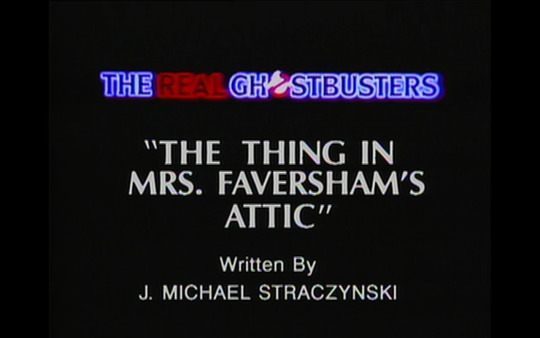
Yes, that J. Michael Straczynski. He was not only a writer for the series but the story editor as well, and the show's quality in its early run reflects that -- until ABC foolishly forced him out (but that's a story for another day).
This episode stands out because of its truly dark subject matter: it involves a haunting in a house caused by an entity -- heavily implied to be demonic in origin -- conjured up by a well-meaning father in dire need.
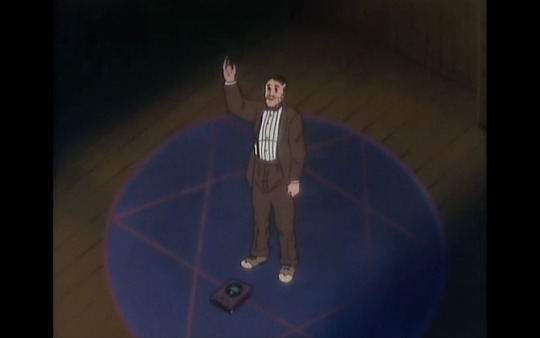
Looking back on it, I can't believe an episode like this got made in the 1980s. Many of you reading this now were not around for it, but the 1980s were a time of baseless widespread fear of rock music, Dungeon & Dragons, cults, and Satanism -- moral panics.
An episode like "The Thing in Mrs. Faversham's Attic" would have normally been nixed by ABC's Broadcast Standards and Practices, but this episode -- along with the two other episodes chosen for this post -- is part of the 65 episodes produced for syndication, meaning that they were subjected to looser restrictions than normal. As you'll see, it's because of those looser restrictions that we see darker themes, more action, and more adult-oriented dialogue. (Frankly, it's still amazing that these episodes got made at all.)
The episode, like many other early episodes of The Real Ghostbusters, has an undeniable internal logic acting as its driving force: the thing in Mrs. Faversham's attic has been confined there, and it's been making that place larger, day by day, year by year, nursing its grudge against the man who trapped it there. It takes on scary forms that are based on the sort of junk that people leave sitting around in attics -- it's both creatively inspired and eminently reasonable.
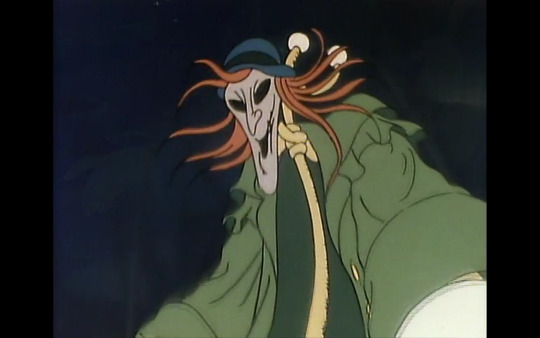
The Ghostbusters also figure all this out through detective work, a process we see in action: after an initial encounter with the thing, they return to the station to ask Mrs. Faversham some follow-up questions based on what they've learned, and Egon is the one who puts all the pieces together in a way that not only is consistent from what we've been shown but also is engaging and interesting to watch. The Ghostbusters aren't just occult-themed exterminators, after all -- they're paranormal investigators, and these three episodes really play up that aspect.
By building an episode around a sort of internal logic -- but not drawing too much attention to it -- and using those rules to bring the episode to the conclusion which follows, a writer can create a resolution which is immensely satisfying, even if the audience is not at first entirely sure why. (Indeed, one of the benefits of script-driven animation is that this internal logic can more easily remain consistent from episode to episode!)
"The Thing in Mrs. Faversham's Attic" also has some examples of excellently-written dialogue -- the dry, wisecracking humor so often associated with the Ghostbusters as well as a really quite menacing speech from the villain (especially menacing when coupled with its design):
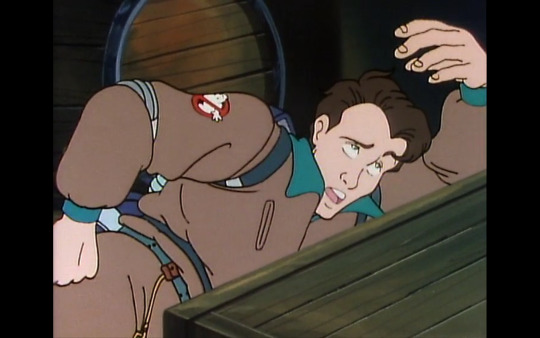
Peter: (talking to himself) "'So, Peter, have a nice day?' 'Oh, yeah. Argued with a hat and a coat rack.' 'Really?' 'Yep, nothing new. How's about you?'"
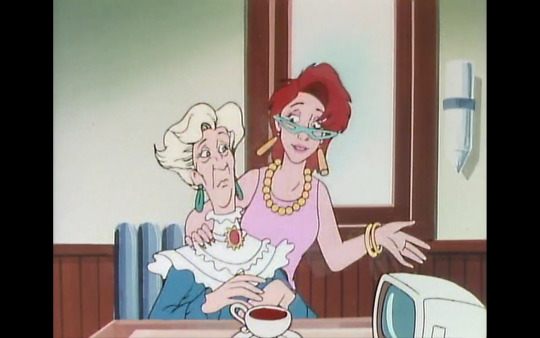
Egon: Janine, why don't you show Mrs. Faversham the Containment Unit? I'm sure she'd find it fascinating.
Janine: Of course. Come along, Mrs. Faversham. I'll show you where they figure out new ways to do stupid things.
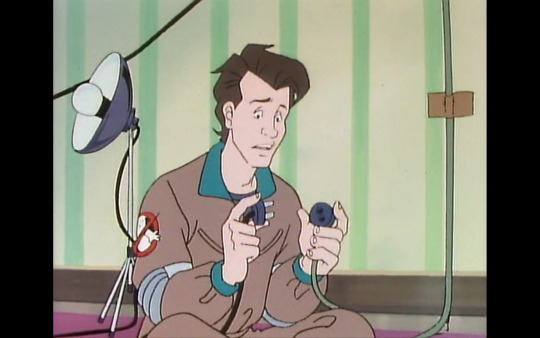
Peter: Seven years of college, and I can never remember if it's positive to negative or positive to positive.
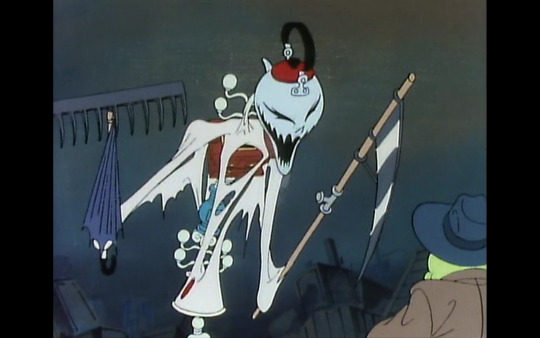
The Thing: So long have I awaited you, Faversham, here in my prison. Do you like it? I built it all myself. Every inch of it has the word hate written on it. That is how much I hate you for keeping me here. Only one thing has kept me from going mad: revenge! Revenge on the one who had imprisoned me! And now, here you are.
I won't spoil the climax of "The Thing in Mrs. Faversham's Attic" for you -- I want you to watch and enjoy all of these episodes for yourself -- but suffice it to say that it is genuinely terrifying, even to adult me.
Episode 41: "The Collect Call of Cathulhu" and Dialogue
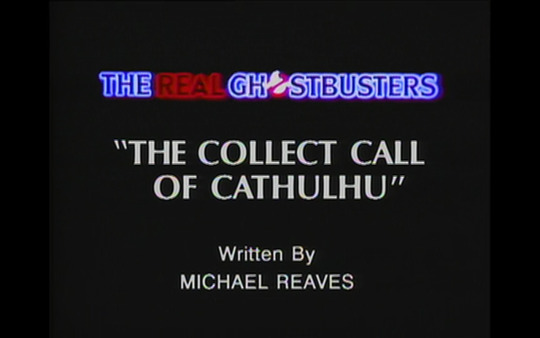
First things first: yes, it should be "Cthulhu" -- the person making the title card thought the name was misspelled (not to mention that Lovecraft's works were not quite yet in the public domain at the time of production). That being said, there's so much to appreciate in this episode; really, it's a love letter not only to Lovecraft but to science fiction writers everywhere. Like every other episode on this list, it also has some great dialogue:

[The Necronomicon has been stolen.]
Kline: We must get it back! Otherwise, the city, perhaps even the world, is in grave peril!
Peter: I don't see what all the fuss is about. It's just a book.
Ray: And an atomic bomb is just a couple of rocks slammed together.
Egon: This is the only English translation of the Necronomicon. If someone were to read the spells in it aloud, the results would be catastrophic.
Using this example, I’d like to show you that good dialogue ought to be doing several things at once:
Dialogue characterizes. We learn about characters through the things that they say, and their words reinforce what the audience already knows about them -- i.e., characters act according to what the writers have previously established. That creates a familiarity with the audience that allows them to get to know those characters. The audience can also learn new things about those characters or gain more awareness of traits that were previously only hinted at -- both of which should be in keeping with aspects that have already been established. (Though it's fine to surprise people, of course. People are indeed complicated and full of surprises.)
Dialogue captivates. Each character's diction -- their manner of speaking and word choice -- should engage the audience by being interesting while also fitting their character. In the example above, Ray is technically-oriented and knows Peter well, so he comes up with a rather surprising metaphor and presents it in a way that Peter can understand -- and the audience is meant to find the gallows humor wryly amusing. (Telling a joke is one way of keeping the audience's interest.) Egon, who is even more technically-oriented than Ray, reflects this with his unusual word choice, particularly in the use of the word “catastrophic”, which also foreshadows just how serious the threat will prove to be.
Dialogue establishes the setting. Characters should refer to the world they live in as if it is ordinary -- i.e., the audience learns something about the world through what the characters have to say about it. With the example above, for instance, we are able to infer not only that magic exists but that it's also extremely dangerous as well. Yet these facts are unremarkable to the characters; the writers assume we're smart enough to make inferences on our own, without them being explicitly spelled out for us.
Dialogue sets the tone and theme. Take another look at the example dialogue above; Peter's flippant remark (which is usual for him) is responded to with grim humor and grave warnings. In a less-serious episode of The Real Ghostbusters, Peter might simply have gotten away with such a remark, but in this episode, he is immediately corrected, establishing that, no, this is far more serious than a normal episode. In addition, the characters' discussion of the danger sets up the theme of magic being a dangerous force that few people can be trusted with.
Dialogue explains what's going on. In my opinion, this is the very last thing that dialogue ought to be doing. Once your dialogue does one or more of the previous things, only then can characters explain what's happening. The audience should learn something new about the immediate subject matter the characters are dealing with, or the plot should be advanced in some way. I don't believe in having expository dialogue simply for its own sake -- but if you think you can make it work in your writing, then go for it. (There are no hard-and-fast rules for writing, and people will like pretty much anything. I've seen it.)
Here's another example of dialogue from this episode:
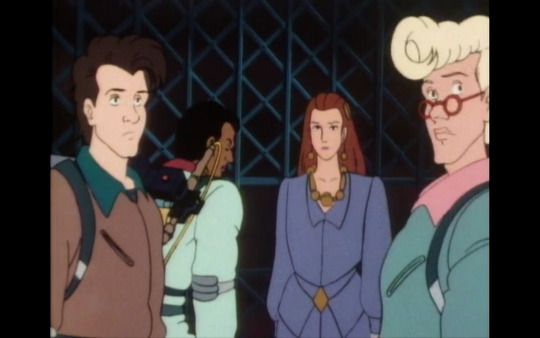
[After running away.]
Winston: Sometimes I really regret answering that ad you guys ran.
Peter: Egon, what do you got?
Egon: His power is completely off the scale. None of our equipment can even begin to stop him. We don't have a prayer.
Peter: You're such a Pollyanna, Egon.
In addition to the dialogue, there are dark elements that got surprisingly overlooked by network censors: the Necronomicon, the cultists -- who, incredibly enough, literally chant "Iä! Iä! Cthulhu fhtagn!" -- the spellcasting, and the riskiness of everything the Ghostbusters end up doing. (I am truly boggled that such an animation was ever made in the Satanist-fearing 1980s.)

Indeed, in order to convey the danger of the threat that the Ghostbusters face, this episode incorporates a number of elements from the film -- which is itself is a serious treatment of a comedic idea -- to give the episode a cinematic treatment. For instance, the opening shot of the New York Public Library is directly lifted from the film, and much of the dialogue -- there's mention of Gozer -- refers back to moments from the film in new and interesting ways, all of it serving to underscore the danger the characters face.

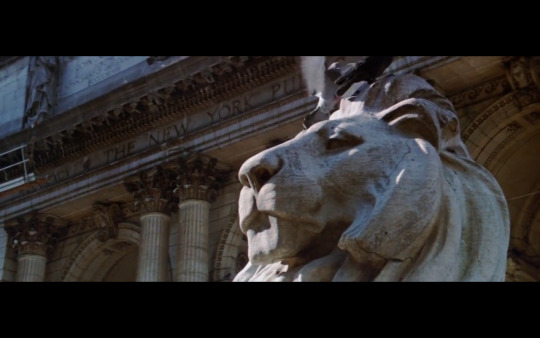
If you watch this episode yourself, you'll see what I mean when I say that this entire episode is a love letter to science fiction writers of old.
Episode 43: "The Headless Motorcyclist" and Conflict
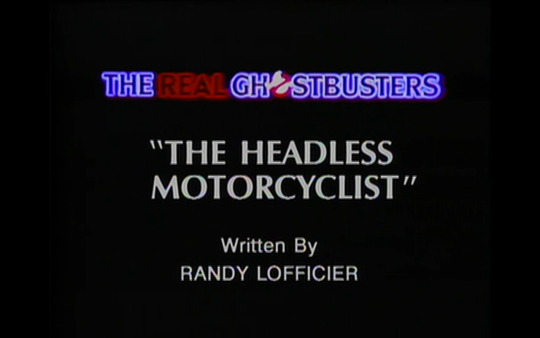
This is my absolute favorite episode, and I saved it for last. There's so much I could say about this episode: I love how cinematic it is; I love that it takes a fictional story from real life and adds some personal tragedy to it; I love the composition and how so many scenes take place on the dark and dirty streets of New York; I love the sophisticated and gritty, almost film noir themes in it (yes, really!); I love how Peter is depicted as the shameless womanizer he is (you know -- for kids!). It's just a perfect episode.
I could bore you for hours by talking about this episode, but I'd like to focus on the conflicts and how the problems these conflicts present offer opportunities for the story to move forward. First, a list of the central conflicts in the story, from beginning to end:
Bud vs. Kate
Peter vs. Bud
Officer Frump vs. Peter
The Headless Ghost vs. Kate (and Her Family)
Officer Frump vs. The Ghostbusters
The Ghostbusters vs. The Headless Ghost
The episode starts with Bud and Kate having an argument at a party. Peter initially gets involved because he's attracted to Kate, but after he overhears the argument and Bud starts to hurt Kate, he steps in, and they almost fight. Bud leaves the party. After Bud leaves, he's followed by the Headless Ghost, who destroys his car. This chance encounter provides the impetus for Bud to contact the police, who naturally assume Peter had something to do with it:
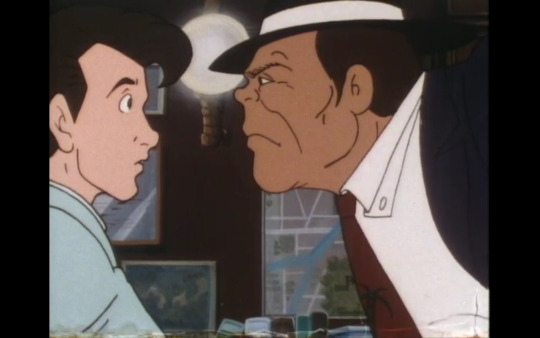
[Officer Frump shows the Ghostbusters photographs of the burnt-out car.]
Officer Frump: And the guy was lucky not to end up the blue plate special at Bob's Barbecue Hut.
Peter: Okay. So you want us to investigate this motorcycle spook, right?
Officer Frump: Wrong.
Peter: Wrong?
Officer Frump: (taking out a photograph of Bud) Know this guy?
Peter: Yeah, sure. I met him last night. We had an argument --
Officer Frump: That's the guy who was almost barbecued.
Peter: (quietly) Ohhhh.
The small conflict between Bud and Peter escalates into a larger one: Peter needs to prove his innocence, or he'll be going to jail for a crime he didn't commit. Because the Ghostbusters are scientists and paranormal investigators, they employ logical thinking in order to solve their problems. Their first idea is to retrace Bud's steps using the same car he drove, which works. After gaining an idea about the ghost, they contact Kate to find out more about the ghost, where they learn about her family's history.
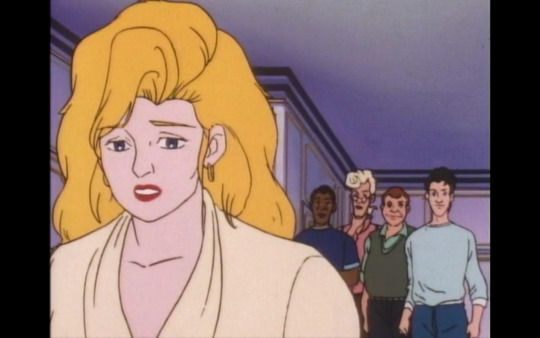
It's then that the Ghostbusters realize the true scope of the conflict taking place and decide to do something about it. By this point, as more information is revealed and multiple parties become involved, further pressure is put on the Ghostbusters -- they need to figure this out, or else they'll all be going to jail -- which ratchets up the dramatic tension.
This is good writing! Start with a small conflict, then raise the stakes. As the characters react to the raised stakes, the situation continues to escalate, propelled by a kind of logic (sometimes a horrible one in particularly violent stories), until a final confrontation becomes impossible to avoid. In “The Headless Motorcyclist”, the Ghostbusters go about their problem-solving methodically; not only is that entirely in keeping with their scientifically-minded characters -- it's also interesting for the audience, especially when their plan is at last revealed.
The dialogue underscores the adult nature of the conflict taking place; read this dialogue and try to remember that this is a kid's show:
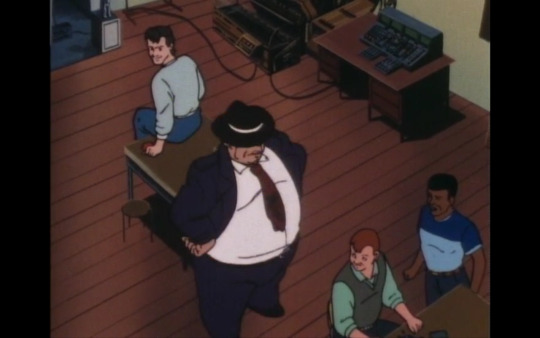
[The Ghostbusters are working on something.]
Janine: (off-screen) You can't just barge in here like this!
Officer Frump: Well, what have we here? Not preparing to let some ghosts loose, are we? By the way, I found that this Bud character is an insurance investigator -- and you were selling ghost insurance at the party. What a coincidence, eh?
I told you that this episode has an almost film noir-ish feel to it, and it's definitely dialogue in scenes like this that help give this episode that extra punch it needs. Even the ending of the episode is some kind of cinematic experience -- just look at the expression on Kate's face and the way the camera pans in:
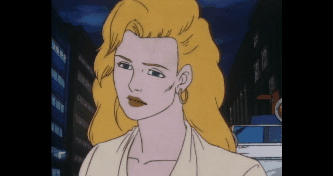
In just a few seconds, you can see all those years of hate and fear of being followed and tortured by the Headless Ghost. We feel her pain in those moments. And yet -- and yet all we're truly looking at in these moments is a bit of paint on a plastic film. To me, that is the epitome of the true magic of animation.
What Do You Think?
If you have Netflix, I highly recommend watching The Real Ghostbusters -- and, in particular, the episodes I mentioned above. Please, please try giving the series a shot. I’ve tried to say as little as possible about the endings -- I think that if you watch these episodes, you’ll be pleasantly surprised, and you may find that you like other episodes as well! Fan favorites include "The Boogieman Cometh", "When Halloween Was Forever", "Ragnarok and Roll", and "Cold Cash and Hot Water".
If nothing else, here are the main ideas in this post I want you to come away with:
The very last thing that dialogue should do is explain what's going on. It should always serve to give life to characters first, then the world, and so on until finally getting to the narrative.
All of your characters in an ensemble cast can have something in common -- a shared dry, sardonic wit, for example -- and yet still be distinct based on other characteristics, such as temperament, word choice, and outlook.
Animation for children doesn't have to be vacuous or insipid. It can be wry, complex, and dark.
Feel free to ignore everything I’ve just told you. I like to give stylistic guidelines on how to write well -- but those are merely my opinions on what good writing is. That is a style. Ultimately, there are no hard-and-fast rules for writing. If you like writing long paragraphs of internal monologue with no line breaks or punctuation, and you think your style works for what you're trying to accomplish, then go for it. There seems to be an audience for just about everything these days, so don’t be afraid to forge your own path.
Thank you for reading this post! I hope you enjoyed it. Feel free to submit any questions you may have, whether on Star vs. the Forces of Evil or The Real Ghostbusters or whatever else is on your mind. If you have sent me questions previously, don't worry; I will answer them soon. If you’d like to chat with me, you can also join me in IRC at the link in my about page, and you can check here for a list of my previous analyses and theories. Take care of yourselves!
#the real ghostbusters#real ghostbusters#dialogue#writing#j michael straczynski#michael reaves#randy lofficier
35 notes
·
View notes
Text
3117 #19: The Real Ghostbusters - Collect Call Of Cathulhu / When Halloween Lasted Forever
Yes, the Saturday morning cartoon based on the Ghostbusters movies tackled the Cthulhu mythos (the spelling in the title is theirs, and must have been an unnecessary copyright dodge). There are lots of fun inside references (especially in one-off character names), and it’s clear the writer of this episode is an HP Lovecraft fan and tried to make things as accurate to his writings as you could in a 20 minute episode of a show whose primary audience is supposed to be children. I particularly like how, while the Ghostbusters remain their usual wisecracking selves, Cthulhu is never portrayed as anything but a serious threat. Slimer, who is the comic relief/”team pet” of the show, is completely absent, which might have been a further sign that they were taking the occult element entirely seriously this time out. Even though the Ghostbusters of course defeat Cthulhu over the course of one night, it’s strongly hinted that they’ve just put off the inevitable, which is the closest Lovecraft has ever allowed to a “happy” ending when it comes to the old gods. 3.5/5
When Halloween Lasted Forever seems to be a bit more typical of the series: Slimer has a fair amount of screentime, and in comparison to the Shoggoth and Spawn of Cthulhu, the goblins villain Samhain use as henchmen are pretty goofy. Samhain himself is pretty scary for a Saturday morning cartoon villain though, and I particularly like the ending: The Ghostbusters look into the containment unit and expect Samhain to be fuming, but instead he’s merely sitting and waiting patiently for his next chance. 3/5
0 notes
Text
Forced Soulmate AU
Danny Fenton and Sam Manson enter the ghost portal shell together when Tucker dares them to both go in. A single entity leaves, a ghost named Nightshade.
Nightshade has snow white hair that falls to their neck and glowing green eyes, and wears a black and white hazmat suit with a circle on their chest. They look at Tucker and call his name as if unsure if its really him, their voice has an eerie echo, like two people talking at the same volume at the same time.
As they reach towards him a ring runs across their body, leaving Sam and Danny desperately holding onto one another. They look at each other for a while, almost seeming to have a conversation without words.
Other things @itshype and I decided for this AU but I couldn't find a way to put into this little story snippet
1). They have to be within arms reach of one another to transform, or it hurts both of them and the transformation isn't nearly as powerful
2). They feel empty when not in close proximity to one another, because their ghost, and thus their souls, have fused together.
3). Their ghost form has traits of both of them, both personality wise and appearance wise. Most traits meet halfway.
4). If they are apart long enough Sam and Danny start to get ill.
5). The Manson Parents are a bit more supportive of Danny in this AU, as Sam's Physical Wellbeing is tied to Danny, and vice versa.
6).When Vlad tries to clone Danny and takes from Nightshade to do it, it makes Ellie Sam and Danny's daughter.
7). They always know in what direction and how far away their other half is. in addition they have telepathy between their human forms, and just between them.
8). Nightshade has all of Phantom's powers, as they are half Phantom, but Sam brings in portals, hypnosis, and fire, amongst whatever else people want to add.
@hdgnj @evilminji @hypewinter @radiance1 @spidori @lolottes @the-witchhunter @mutable-manifestation
156 notes
·
View notes
Text
There is a King.
The King is a child and the child is King. The King is dwarfed by His regalia. The Crown rests upon his shoulders. The Cloak drapes behind him like a bridal train. The Ring rests not upon the King's wrist but his arm. The King is a child and the child is King.
The King is a ghost and the ghost is King. The ghost died too young. Much too young. The ghost is small. Much too small. The King is thin. Much to thin. It is known that you never ask how a ghost died, but it is tempting. The King is a ghost and the ghost is King.
The King is a warrior and the warrior is King. The warrior fights day in and day out. But not for power, nor for greed. The warrior doesn't fight to make other suffer. The warrior fights because he is attacked. And attacked. And attacked ever more. The King is a warrior and the warrior is King.
The King is a protector and the protector is King. The protector does his duty for there are no others to protect. The protector does his duty for he feels responsible for the invaders. The King is a protector and the protector is King.
The King is many things. The King is a child, a ghost, a warrior, and a protector. The King suffers for the child who is drowning in the trappings of power. The King mourns for the ghost who died before he even had his first love. The King fights for he is a warrior who fights when he is attacked and not a moment before. The King defends his charges that he protects for he feels responsible for their danger.
The King is Phantom and Phantom is the King. Long Live The King!
@hdgnj @evilminji @itshype what do yall think of the blurb I wrote?
18 notes
·
View notes
Text
The-man-who-once-was looks upon the demon-who-is-now and the monster-he-is-becoming with sadness and weeps for them, for they are what he feared to be and what he decided to be upon a vow of protection. He weeps for the humanity he gave up freely and willingly to protect those who would die without his intervention. He weeps for those who followed him until they fell in their shared mission.
The demon-who-is-now screams. He screams in rage and he screams in pain. In grief and joy and a thousand other, fleeting emotions. He screams a challenge to the monsters that feast upon flesh and haunt minds and he screams reassurance to those that he protects. That so long as he stands they will live.
The monster-he-is-becoming laughs. Laughs in joy and in pain. He laughs in mountains of broken bodies and rivers of blood. He laughs and laughs to hide the weeping and screaming he once did. He laughs to distract from the pain of abandoning all that he once was and could have been. He laughs to inspire fear in the fearless, and to inspire hope in the hopeless.
For he was the man to first to fight back and weep for those he couldn't save. For he is demon screams his defiance for all to hear. For he becoming the monster who laughs at yet another tragedy. For he is Brimstone and Hellfire, for that is where he made his home.
4 notes
·
View notes
Text
It had always called to him, the oceans had. Or more specifically, the Atlantic Ocean had. It called like homesickness, an ever-present urge to Go There.
Adrian never had any reason to go to the middle of the ocean though. He knows it's the ocean because he toured Europe once to see if he could find The Call. He never had any reason at all, until The Reawakening.
Suddenly Magic was working for anyone with even a spec of magical power. Suddenly monsters roamed the land, sky, and sea. Suddenly, there was a reason to leave his hometown in the mountains to search the oceans.
The first thing Adrian noticed was that he felt strange as he got close to the oceans. Stronger, not physically stronger though. Stronger like a storm compared to a hurricane. Stronger like a tide compared to a tsunami. Stronger like Magic.
Unsurprisingly, nobody wanted to take him to the middle of the ocean and look for some vague call that only one man could feel. So Adrian went down to the beach one night and screamed his frustration at the ocean. And the ocean receded several yards, gathering into an almost six foot tall wall of water. A local college wanted to know how (and why) he'd done that after they pulled him from the accidental wave he'd made. And he explained the Call he'd always felt, and how it was growing stronger as he got closer. And so he found a ship and crew both capable and willing to bring him to the middle of the ocean.
At least, until he dove off of it. Until his voice rang in the air and water with the power of a hundred hurricanes.
"RISE ATLANTIS"
Until a city of blue and green stone rose foot by foot from the suddenly choppy ocean, water running down somehow pristine streets and draining into the ocean. They found Adrian, wearing a crown and carrying a trident of blue and silver. They had found a safe haven in the world of magic and monsters. They has found the Lost King of Atlanis, the Unsinker, Adrian Atlante.
0 notes
Text
Story I'm going to try to write
Follows "Brimstone" "Atlante" and "Hearthfire" through their individual yet connected journeys to try to save as many people as possible from an apocalypse.
Brimstone And Hellfire, who took his name from where he walk to try and save one more person
Atlante, who took his name from the city-state he rules over
Hearthfire, who took her name from the dozens and hundreds of homes she tries to save
And an uncountable number of enemies seeking to destroy all they know
0 notes
Text
At 11:34 on All Hallows Leave Gotham screamed like the dammed. And for one minute, a mere sixty seconds, the Dead could be seen.
0 notes
Text
Truck-Kun Izuku
Truck-Kun Izuku
by Cathulhu Writes
Izuku gets his quirk by running away. Just his luck it would be a truck themed quirk? And a gamer quirk? Who cares? he'll become a hero anyways.
Words: 489, Chapters: 1/?, Language: English
Fandoms: 僕のヒーローアカデミア | Boku no Hero Academia | My Hero Academia
Rating: Not Rated
Warnings: Creator Chose Not To Use Archive Warnings
Characters: Midoriya Izuku
Additional Tags: Tags to be added, Midoriya Izuku Has a Quirk, Midoriya Izuku Does Not Have One for All Quirk
Read Here: https://archiveofourown.org/works/42607395
3 notes
·
View notes
Text
Emerald Spark- One for Hyrule
Emerald Spark- One For Hyrule
by Cathulhu Writes, Fire of Chaos
Izuku gets unexpectedly pulled to Hyrule roughly five years after the Great Calamity (the Age of Burning Fields), and promptly decides to do the Izuku things, like trying to save an entire world when he doesn't understand a single word that people are saying.
Words: 584, Chapters: 1/1, Language: English
Fandoms: The Legend of Zelda: Breath of the Wild, 僕のヒーローアカデミア | Boku no Hero Academia | My Hero Academia
Rating: Not Rated
Warnings: Creator Chose Not To Use Archive Warnings
Characters: Midoriya Izuku
Additional Tags: Isekai, Midoriya Izuku Has One for All Quirk, Midoriya Izuku in another World, POV Multiple
Read Here: https://archiveofourown.org/works/41981436
3 notes
·
View notes
Text
Home, the Long Ways
Home, The Long Ways
by Cathulhu Writes
To whomever is reading this journal, this is my record of what I, Izuku Midoriya, have been through. This, is my journey Home, the long way around. And I swear that I'm not making this up, no matter how fantastical it sounds.
Words: 880, Chapters: 2/?, Language: English
Fandoms: 僕のヒーローアカデミア | Boku no Hero Academia | My Hero Academia, Assassination Classroom
Rating: Teen And Up Audiences
Warnings: Creator Chose Not To Use Archive Warnings
Characters: Midoriya Izuku
Additional Tags: Midoriya Izuku writes a journal
Read Here: https://archiveofourown.org/works/39672945
3 notes
·
View notes